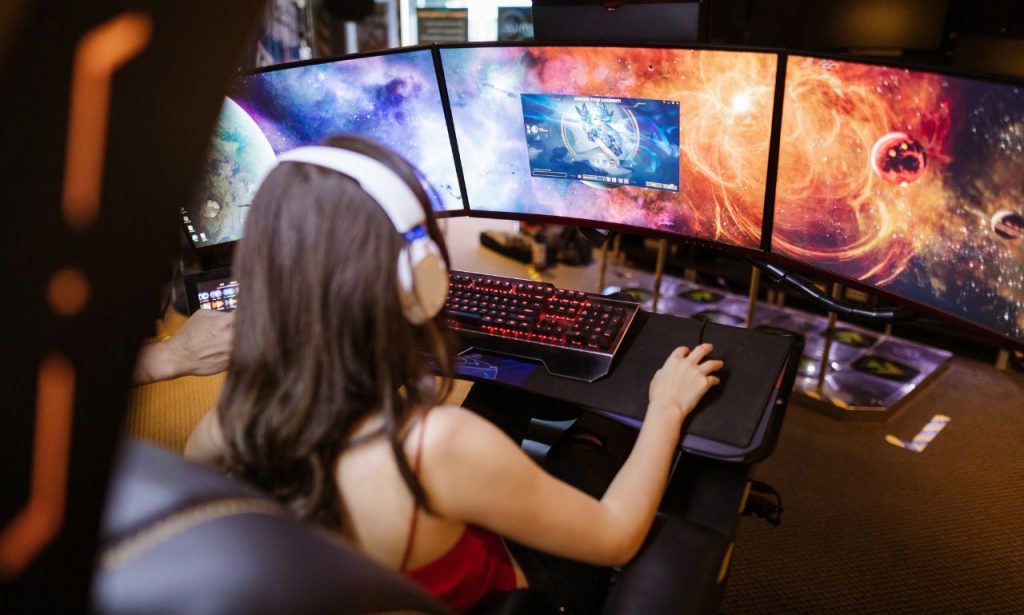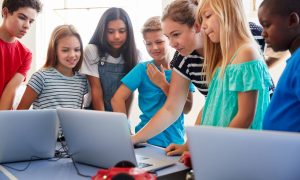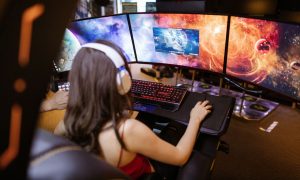In today’s classrooms, gaming design is changing how students learn. This article examines the distinction between game-based learning and gamification. We will discuss its impact on skill acquisition, personalized and collaborative experiences, and career readiness. You’ll also learn about digital literacy, the rise of esports, and strategies for teacher training. By the end, you’ll have actionable insights to bring gaming into any K–12 curriculum.
Game-Based Learning vs. Gamification
Game-based learning embeds educational content directly within gameplay. Students tackle math problems as they guide a character through a quest. Lessons become challenges instead of lectures—gamification layers game mechanics, such as points, badges, and leaderboards, onto traditional assignments to boost motivation. Schools using Classcraft report a 30% increase in homework completion over a semester, attributed to the integration of point systems and boss battles into daily tasks. At Lincoln Elementary, third graders built vocabulary skills by “leveling up” avatars in a vocabulary RPG created by their teacher. That project showed a 20% jump in test scores compared to classes without gamified elements. When comparing both approaches, game-based learning offers deeper immersion, while gamification provides quick engagement hooks. A balanced blend taps into curiosity and drives learning outcomes.
Impact on Skill Acquisition

Students develop critical thinking when they troubleshoot puzzles in educational games. They learn to adapt strategies on the fly, mirroring real-world problem-solving. For example, “Lightbot” teaches programming logic by having students sequence commands to light up tiles. Over 500,000 downloads on the App Store demonstrate how kids grasp loops and conditionals through play rather than sit-down coding drills. Social studies games, such as “Mission U.S.,” allow learners to replay key moments in American history, improving retention by up to 40%, according to a study from the Joan Ganz Cooney Center. Children who engage in a simulated Harlem Renaissance experience report stronger recall of dates and figures. These interactive experiences foster cognitive development in ways textbooks alone can’t match. They reinforce abstract concepts through trial and error, making learning more effective and lasting.
Personalized and Collaborative Experiences
Adaptive learning systems adjust difficulty based on each student’s performance. Platforms like DreamBox Math analyze every click and hint request, customizing lessons in real time to provide a personalized learning experience. That individualization ensures students neither coast on easy tasks nor get stuck on overly complex challenges. Meanwhile, collaborative games encourage peer-to-peer teaching. In “Minecraft: Education Edition,” teams design sustainable cities, splitting roles—architect, planner, and engineer—to solve resource management scenarios. One study found a 25% increase in teamwork skills when students collaborated on projects in virtual environments. Teachers at Roosevelt High noticed that quieter students were taking the lead in block-building assignments. Those learners gained confidence in speaking up and delegating tasks, bridging social gaps in their classrooms.
Preparing Students for Future Careers
Gaming design reflects many of the 21st-century workforce’s demands. Students who guide avatars through project management quests practice planning, resource allocation, and deadline management. Simulations like Microsoft Flight Simulator spark interest in aviation careers; some high schools now run flight-sim labs to prepare budding pilots. A recent report from the International Society for Technology in Education highlights that 70% of employers seek candidates comfortable with digital simulations and virtual collaboration platforms. By integrating game design modules—such as level design, storytelling, and UX principles—into electives, schools equip learners for roles in technology, marketing, and beyond. When teens build simple games using Scratch or Unity, they acquire skills in coding languages, asset management, and creative problem-solving. That experience pays off in internships and beginner programming roles, giving students a head start in competitive fields.
Importance of Digital Literacy
Digital literacy goes beyond knowing how to operate a device. It includes understanding media ethics, privacy, and norms for online collaboration. Games can teach these lessons without feeling preachy. In the “Digital Compass” game, students navigate social media scenarios, making choices that affect their virtual reputation. That interactive approach shows consequences more vividly than lectures. Educators at Jefferson Middle School saw a 50% reduction in cyberbullying incidents after students completed the game-based module. Embedding these lessons in game contexts ensures they resonate more effectively. Children learn to evaluate sources, protect their data, and practice empathy in online environments. Those skills remain critical as digital platforms continue evolving.
The Rise of Esports in Education
High schools across the U.S. are launching esports teams to tap into students’ passion for gaming. Titles like Rocket League and League of Legends attract a diverse crowd, ranging from aspiring engineers to creative storytellers. Some districts allocate school credit for varsity-level competition, treating esports in the same manner as any other athletic program. That shift has unlocked scholarships: more than 200 colleges now offer esports scholarships, some exceeding $30,000 annually. At Lincoln High, the Rocket League team boosted school spirit and attendance, with members reporting a 15% rise in GPA after joining. Coaches emphasize communication, strategy, and time management, translating in-game success to classroom performance.
Esports as a Tool for Personal Growth
Losing a match prompts self-reflection on strategy and areas for improvement. Those post-game debriefs teach a growth mindset far better than pass/fail grades. Players also develop emotional regulation skills. Maintaining composure under pressure in a live bracket match mirrors challenges in high-stakes presentations or debates. Leadership emerges as captains coordinate rosters, manage scrimmages, and set practice schedules. Julie Nguyen, captain of her school’s Smash Brothers team, credited her leadership role with landing a summer internship at a local game studio. Experiences like hers illustrate how organized gaming can open doors traditionally reserved for student-athletes.
Implementation Challenges and Solutions
Budget constraints, infrastructure gaps, and teacher buy-in pose hurdles. Many schools lack robust Wi-Fi or sufficient devices to run graphically intense titles. Districts can overcome that by rotating game labs or leveraging cloud-streaming services like NVIDIA GeForce Now for Education. Licensing costs spring up next. Open-source and free-to-play titles help mitigate expenses. Teachers often worry about classroom management when screens come out. Structured lesson plans with clear objectives and time limits keep students on track. Peer mentors—tech-savvy students—can provide real-time support, freeing educators to focus on instructional goals.
Aligning Games with Curricular Standards
Mapping game mechanics to learning objectives ensures alignment with state standards and educational goals. For instance, an ecology game that simulates forest management can address NGSS standards on ecosystems and resource cycles. When students adjust variables like deer population or rainfall, they observe cascading effects. Assessments can include in-game challenges as performance tasks. After each session, learners submit reflective journals that outline the strategies used, the data collected, and the conclusions drawn. Those narratives mirror lab reports in science classes. Integrating rubrics for both gameplay and writing assignments fosters a blend of engagement and accountability. Districts using this model, such as Portland Public Schools, report more meaningful evidence of standards mastery compared to traditional tests.
Teacher Training and Strategic Implementation

Educators need hands-on workshops to experience games from a learner’s point of view. Training sessions that simulate student use cases highlight both the pedagogical potential and pitfalls. Schools partnering with organizations like ISTE offer summer institutes focused on game-based learning design. Follow-up coaching and peer observation reinforce new skills. Creating communities of practice—teachers sharing lesson templates, troubleshooting tech issues, and co-designing modules—builds momentum. Districts that invest in ongoing training see higher adoption rates and more innovative classroom applications.
Importance of Teacher Training Programs
Practical programs balance theory and practice. They introduce learning science principles—such as cognitive load, intrinsic motivation, and scaffolding—and demonstrate how games embody these concepts. Micro-credentialing, where teachers earn badges for mastering specific competencies (e.g., “Designing Level-Based Assessments”), adds motivation. That badge becomes a marker in performance reviews or salary-step processes. Schools in Chicago Public Schools that piloted micro-credentials for game design saw a 60% increase in teachers implementing digital games within six months. Peer-led training, where teacher leaders demonstrate classroom use, fosters trust and drives broader school buy-in. That ripple effect makes sustainable, school-wide culture change possible.
Conclusion
Gaming design has leaped from entertainment to an educational powerhouse. It drives skill acquisition, personalizes learning pathways, and equips students for tomorrow’s careers. When digital literacy and esports join forces, classrooms become dynamic labs for real-world problem-solving. Implementation challenges can be addressed through strategic planning, budgeting, and robust teacher training programs. Educators willing to experiment today will harvest engagement gains and deeper learning tomorrow. Ready to level up your classroom? Start small, measure impact, and scale wins.
ALSO READ: How Does Edtech Help Students and Teachers
FAQs
Game-based learning weaves educational content into gameplay, creating immersive experiences that teach skills through challenges. Gamification incorporates game elements—such as points, badges, and leaderboards—into existing lessons to enhance motivation.
Yes. Studies show that digital game-based learning can increase test scores by 15–20% in subjects such as math and reading comprehension by providing interactive practice and immediate feedback.
Costs vary depending on the title and infrastructure requirements. Free or open-source games and cloud-streaming services help keep expenses low. Initial investments often yield returns through enhanced engagement and improved performance data.
Educators benefit from training in both pedagogy and technology tools. Professional development workshops and micro-credentials in game design principles equip teachers to effectively integrate games.
Esports teams teach transferable skills—such as teamwork, communication, and resilience under pressure—that benefit all participants. Even students who watch or support teams develop digital citizenship skills and form connections within their school community.




